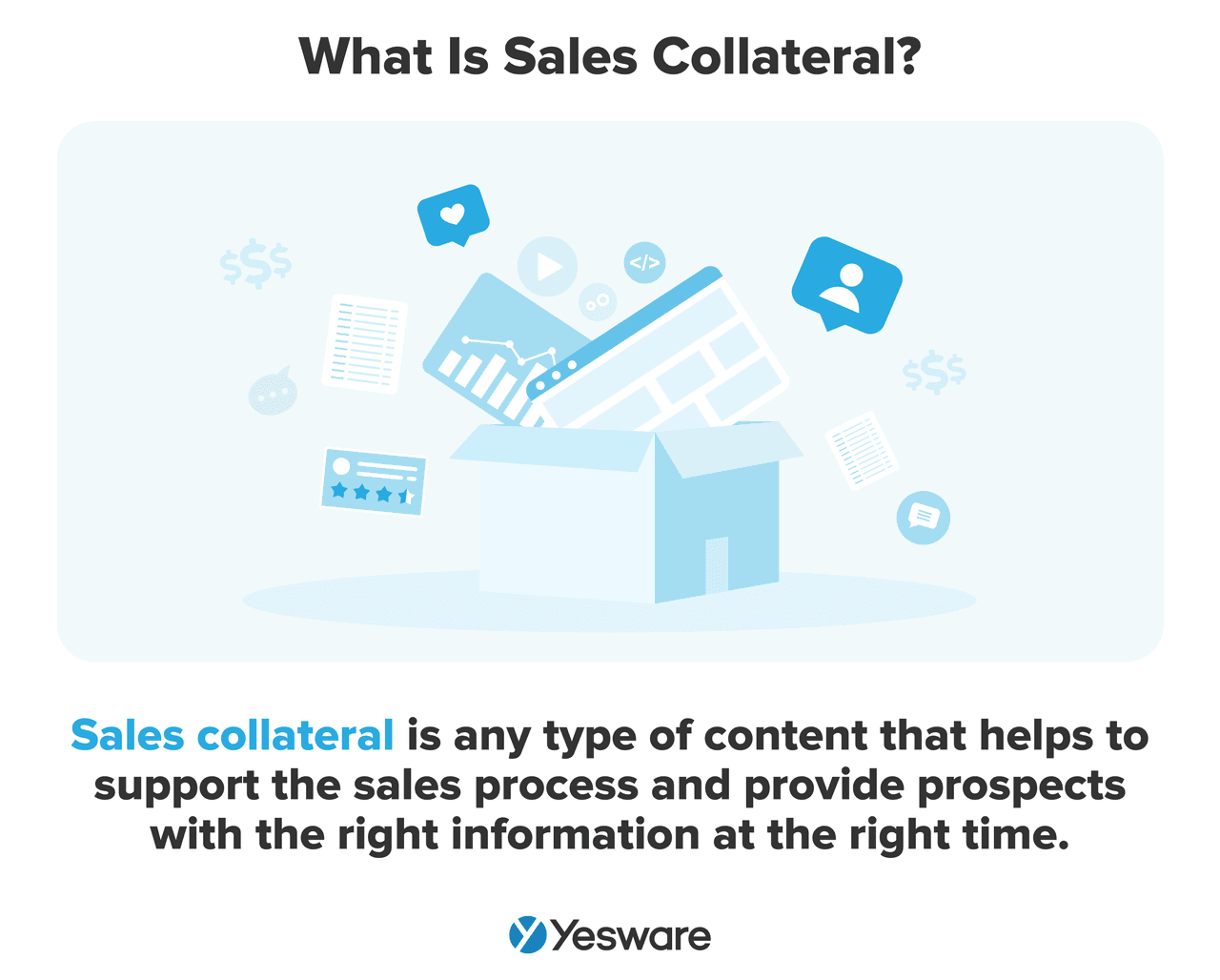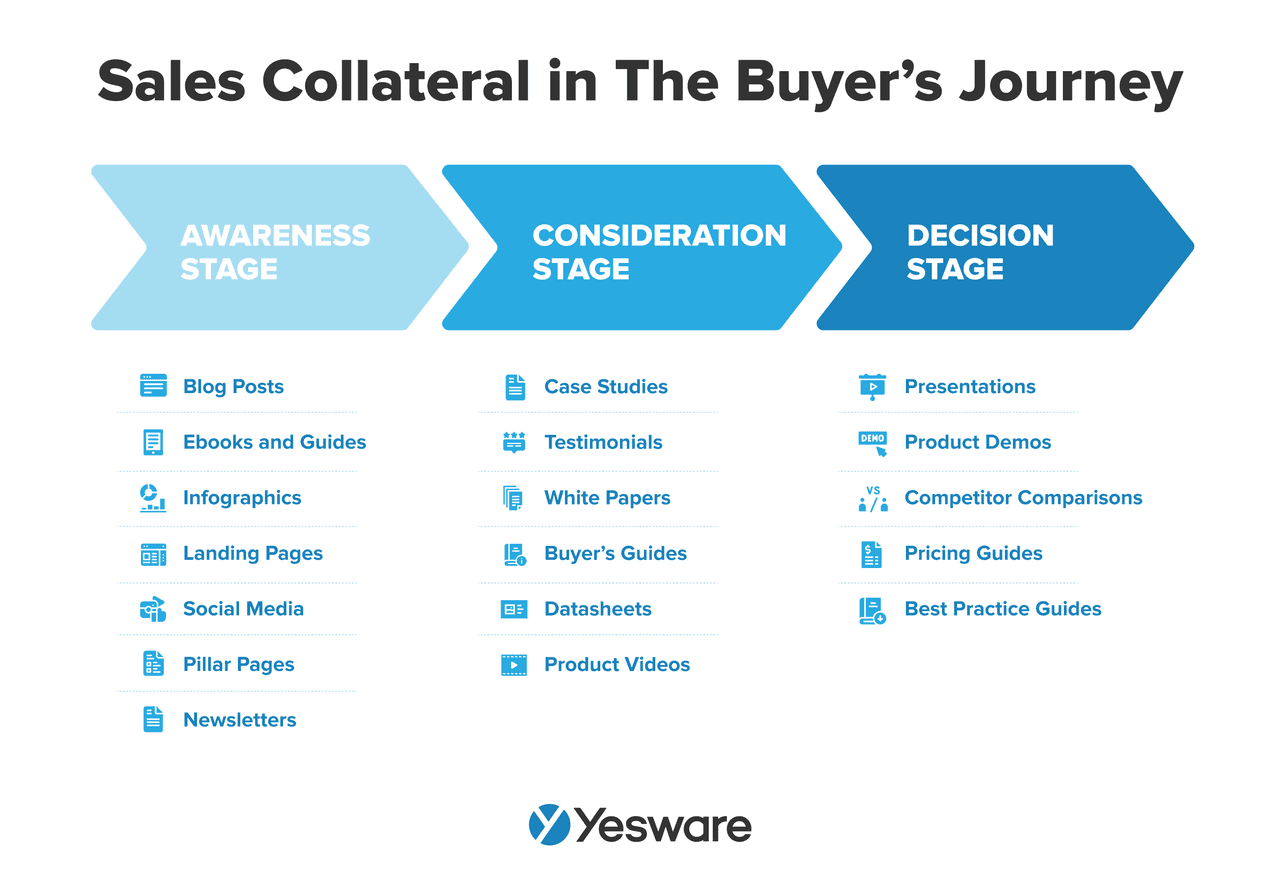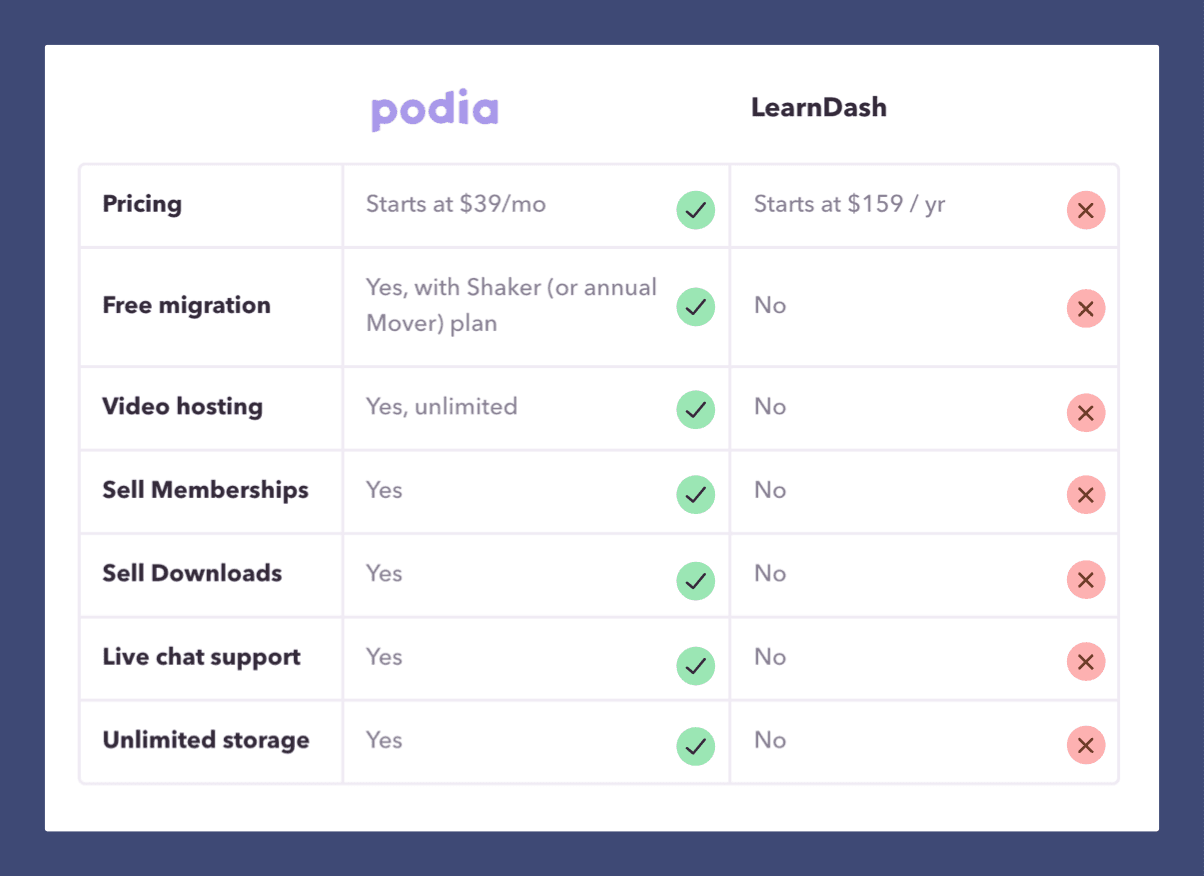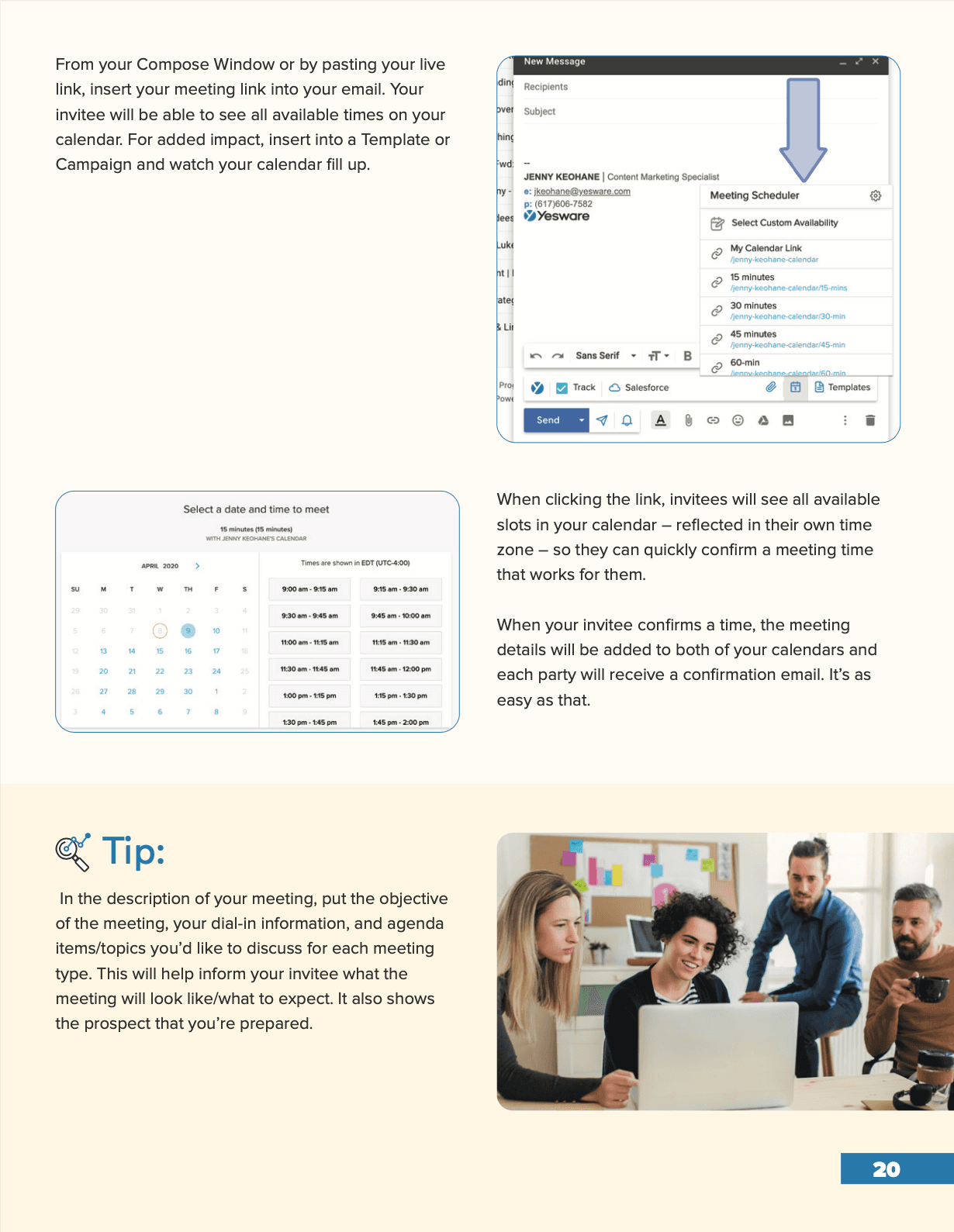How to Leverage Sales Collateral in The Buyer’s Journey [Examples]
Jenny Keohane
Gone are the days of using traditional sales collateral that consists of brochures and catalogs. In today’s hyper-competitive landscape, modern sales collateral needs to effectively engage and persuade prospects to maintain momentum and drive sales.
The harsh reality is that 78% of executive buyers claim salespeople do not have relevant materials to share with them. This indicates a gap in what sales and marketing teams are producing vs. what prospects actually want.
If done right, sales collateral demonstrates the value and drives context in your sales conversations. Providing this material not only enriches the prospect’s experience with your company but helps to give them that extra push to purchase.
Let’s look at sales collateral examples, how to align sales collateral to the buyer’s journey, best practices, and more.
Here’s what we’ll cover:
- What is Sales Collateral?
- Types of Sales Collateral in The Buyer’s Journey
- Sales Collateral Examples
- Sales Collateral Best Practices
- How Should Salespeople Use Collateral
What is Sales Collateral?

Sales collateral is any type of content that helps to support the sales process and provide prospects with the right information at the right time.
Sales professionals use sales collateral in the buyer’s journey to help prospects make decisions and ultimately convert those prospects into customers.
The material helps to drive context, provide value, and ease prospective concerns.
Types of Sales Collateral in The Buyer’s Journey
The type of sales collateral used will depend on what stage your buyers are in the buyer’s journey.
First, what is the buyer’s journey? The buyer’s journey is a framework that outlines the path a buyer takes to purchase a product or service.
The framework is broken down into three stages: awareness, consideration, and decision. It starts from the moment a buyer starts to realize they have a problem that needs fixing and ends after they’ve decided on a solution and made their purchase.

With this framework in mind, sales and marketing teams must create sales collateral that compliments each stage of the buyer’s journey. That way, the content is tailored to exactly what the buyer needs at exactly the right time. Because as buyers move through the buying process, their needs change.

Below we break down the best types of sales collateral for each stage of the buyer’s journey and what the purpose and goals are of each piece.
Sales Collateral for the Awareness Stage
Sales collateral for the awareness stage helps to introduce your product and get the right buyers interested.
Awareness stage sales collateral consists of:

Blog Posts
Blog posts are informative articles that cover a specific topic or query. This type of content demonstrates thought leadership and authority in the market and helps bring awareness to your brand in a non-direct selling way.
Ebooks and Guides
Ebooks are digital books that are focused on a specific topic and are typically gated, which means users must enter their information in order to download. This is a great way to generate not only awareness of your brand but also a list of warm leads.
Infographics
Infographics demonstrate information in a visual way. This form of sales collateral allows users to quickly digest information, whether that be step-by-step guides or industry-specific data.
Landing Pages
Landing pages are standalone web pages that are often used for marketing purposes but can also be an effective form of sales collateral. A few examples include a comparison page to a competitor, a case study page, or a particular offer or incentive.
Social Media
Social media is an interactive way of establishing thought leadership in the market. This social network isn’t just used to social sell but also to bring awareness to your brand with relevant posts targeted at your buyer persona.
Pillar Pages/Content Hubs
Pillar pages are pieces of content, each about a specific topic, that serve as the foundation of a topic cluster (a collection of blogs related to that topic). They help show your audience that your brand is an expert on these topics, which typically are relevant to your product/service.
Newsletters
Newsletters are periodical communication to subscribers that help your brand stay top-of-mind. This communication allows you to frequently re-demonstrate your thought leadership in the market.
Sales Collateral for the Consideration Stage
Sales collateral for the consideration stage helps to guide buyer conversations and build rapport. In this stage, customers are looking into different options to help solve their problems. So, it’s important that your collateral emphasizes the value of your solution.
Consideration stage sales collateral consists of:

Case Studies
Case studies help demonstrate the power of your product or service through the experience of another company. This type of sales collateral demonstrates the pain points your customers experienced before your solution and how it has solved these problems for them.
Testimonials
Testimonials are a shorter and more direct form of case studies. They demonstrate the value of your product or service through the words of happy customers.
White Papers
White papers are in-depth reports that help to educate prospective customers on a specific topic. They present a problem and help provide a solution. When used as sales collateral, that solution is typically the product or service that you’re selling.
Buyer’s Guides
Buyer’s guides are pieces of content that help customers make informed buying decisions. This type of sales collateral helps guide the prospect to the close faster by providing all the information needed during the consideration stage in one easy-to-access place. For a more quick, high-level overview of a specific feature, leverage sell sheets.
Datasheets
Datasheets are documents that summarize the characteristics of a product or service. This is great for the consideration stage because it gives your prospects the information they need to make informed decisions.
Product Videos
Product videos demonstrate your product’s features and functionality. This form of content is easy for prospects to digest and is a great way to portray your product’s benefits first-hand.
Sales Collateral for the Decision Stage
Sales collateral in the decision stage is the final nudge to get prospects to purchase. The collateral at this stage needs to reinforce the value of your solution and instill why it’s the right choice over competitors.
Decision stage sales collateral consists of:

Presentations
A sales presentation showcases your product or service with the goal of persuading your prospect to buy. A strong sales presentation tells a story, highlights your value proposition, and motivates your prospect to take action.
Product Demos
Product demos are live demonstrations of your product/service and its functionalities. This demonstration highlights the value and benefits of your solution. Each product demo should be tailored to the specific use case of the prospect you’re talking to.
Competitor Comparisons
Competitor comparisons are exactly what they sound like, a comparison breakdown between your product and your competitor’s. This form of sales collateral is super beneficial for the decision stage because prospects are typically evaluating multiple solutions.
Pricing Guides
Pricing guides break down your pricing structure in an easy-to-understand way for prospects who are deciding which plan is best for their team. Price plays a huge role in the decision stage, so it’s important to provide prospects with the tools they need to dissect it.
Best Practice Guides/Playbooks
Best practice guides or playbooks are documents that walk through strategies and tips for using a product or service to the best of its ability. This form of sales collateral is a great push for customers who are debating signing because it shows them you want them to succeed and how exactly they can do that with your offering.
Sales Collateral Examples
Case Studies
Case studies are hands-down one of the most effective types of sales collateral because of the power of social proof.
Nobody wants to be the guinea pig. Decision-makers want proof that your product will solve their problems and one of the best ways to do that is to provide them with 3rd party evidence.
In short, case studies tell a story of how a customer achieves success with your solution.
Studies show that case studies can increase your deal closing ratio by 70% and your sales by 185%.
Keep in mind that your case study should be relevant to the prospect and their company. The company in the case study should ideally be similar in regard to industry, company size, and issues faced.
Your case study should address:
- The pain points and challenges faced by the customer before your solution
- How it was implemented
- The outcome/results of adopting the solution (use hard data and stats here)
If done right, your case studies will ensure the buyer that you’re a reputable company that delivers results.
Here’s a general case study template:

Tip: Case studies can be used throughout the sales cycle and at different stages of the buying process depending on the buyer’s needs and the conversation taking place.
Sales Presentations
Sales presentations take a personal approach and help build connections with prospects. As stated above, a strong sales presentation tells a story, highlights your value proposition, and motivates your prospect to take action.
Here’s a general layout of a sales presentation:

There are various routes to take when creating your sales presentation — you can present a general overview of your company and solution or create a more hyper-focused presentation that focuses on features and the product itself.
Here’s an effective story-telling formula for your presentation:
- Before → Here’s your world…
- After → Imagine what it would be like if…
- Bridge → Here’s how to get there.
Start with a vivid description of the pain, present an enviable world where that problem doesn’t exist, then explain how to get there using your solution.
The key here is to have a general branded template that you can fill out/personalize for each company. And always provide engaging visuals.
For example, which is more effective for you? This statement — “On average, Yesware customers save ten hours per week” — or this image:

The graphic above displays what those 10 hours look like for prospects vs. customers. It also calls out a pain that the solution removes: data entry.
Visuals are more effective every time; they fuel the retention of a presentation from 10% to 65%.
Competitor Comparison Sheets (Battle Cards)
Another benefit of sales collateral is that it can help you overcome sales objections. And we all know that one of the most common objections faced in the sales process is our very own competitors.
Competitor comparison sheets, also known as battle cards, help visualize how your solution stacks up against your competitors. These are typically one-pagers that highlight the differences between you and a company. This can be as simple as a side-by-side chart comparing each solution’s features and functionalities.
Your sales team should have access to these battle cards for all of your top competitors. That way, when your competitor’s name comes up in conversation, you’re equipped with the right material to show the decision-maker why your solution is better.
Here’s a standard example:

Best Practice Guides/Playbooks
You can take various routes when creating playbooks. This type of collateral provides a framework for professionals to help them do their job better.
One of the most influential playbooks you can create is one that shows your prospects how they can achieve better results with your solution.
An example of this is creating a product guide that consists of best practices, tips, and tricks for using your solution — this not only provides the prospect with insights into effective techniques but does this while selling them your solution.
Here’s an example of what we use here at Yesware:

And here’s a look inside:

FAQ Sheets
FAQ sheets assist the prospect with questions that typically arise in the sales process. This helps to continue the momentum and address questions quickly and effectively.
As a sales professional, you know the questions that frequently arise throughout your sales conversations. So, start jotting these down throughout your day and compile a list of frequently asked questions.
Then, create a sheet answering these questions that align with your strategy and messaging. This not only saves you time answering tedious questions but also shows the decision-maker that you’re prepared and organized.
Keep in mind that these questions should serve a purpose and help to highlight your advantages over competitors. Make sure your FAQ sheet is helpful and informative but also uses language that persuades.
Here’s an example of a FAQ sheet template:

Product Videos
Aside from demos, product videos are the best way to show your prospects how your product works before purchasing. By sending product videos, you allow them to view and obtain all information on their own hands before proceeding.
Efficient sales and marketing alignment here is necessary. Never underestimate the power of sales reps and marketers working together.
Over here at Yesware, we created a learning portal called Yesware U where customers can access videos on their own. Our sales team uses this portal to send prospects videos and articles daily.

The portal helps prospects navigate our solution on their own as well as gives our sales team easy access to all up-to-date product videos where they can grab links and send them to prospects in seconds.
Tip: Looking for more tips and strategies to improve your sales conversations? Grab our free ebook below, filled with data findings from millions of email activities over the past few years.
 Sales Engagement Data Trends from 3+ Million Sales ActivitiesLooking at millions of tracked email activity over the past few years, this ebook is filled with our top studies and findings to help sales teams accelerate results.
Sales Engagement Data Trends from 3+ Million Sales ActivitiesLooking at millions of tracked email activity over the past few years, this ebook is filled with our top studies and findings to help sales teams accelerate results.
Sales Collateral Best Practices
Identify the Audience for Each Piece of Sales Collateral
Each piece of sales collateral should be created intentionally to match a specific buyer in a specific stage of the buyer’s journey. It’s important to remember that as buyers move through the buying process, their needs change.
Sales and marketing should have a thorough understanding of how buyers make purchasing decisions in order to create and deliver tailored content that organically guides prospects through the buying process.
And this knowledge doesn’t need to come from just your sales and marketing teams. You can get first-hand information about what your audience wants to see and what would better support them by asking your current customers for feedback, such as sending out a survey or holding a focus group.
Create Sales Collateral Templates
For quick and easy personalization, build out general templates for each type of sales collateral. Then, when you need to send the collateral to a prospect, you can personalize the piece so it’s tailored to that specific prospect and company.
As stated above — alignment between your sales and marketing team is crucial. The best way for your teams to collaborate on this is by establishing ready-to-use templates that can be personalized and delivered quickly and effectively.
Ensure Accessibility
The last thing you want is for your prospects to have difficulty opening your documents. Ensure easy accessibility before sending any material out.
Always communicate to the prospect in advance before sending documents by email to ensure smooth deliverability.
Tip: Try descriptive links to avoid emails going to spam.
Track Attachment Engagement
Sending sales collateral is a game-changer when you can gauge which piece is most effective, what needs more work, and who your most interested prospects are.
Attachment Tracking tells you whether recipients are clicking on the attachment, interacting with it, and how much time is spent on each page. This not only tells you the interest level of the prospect but also reveals the effectiveness of the collateral itself.
Here’s an example of Yesware’s presentation report:

Sales is all about identifying what exactly is resonating with your prospects, then refining that strategy and leveraging it. By tracking your sales collateral, you’ll be able to fine-tune your pieces and collateral strategy a step further.
Provide Context Around Your Sales Collateral
Never send your sales collateral out of the blue. Always give a brief explanation of what the recipient should expect and why you’re sending it.
If the collateral is relevant, mentioning it should flow seamlessly in your conversation. It can also be effective to follow up about the collateral to ask about opinions and if they’re satisfied/need any more information.
Always Update Your Collateral
Companies are constantly changing and evolving. Make sure to stay up-to-date with your sales collateral and double-check for any updates or recent changes before sending the pieces out.
An example of this is in your battle cards — by providing outdated information, you immediately lose the prospect’s trust. Stay on top of your competitor’s product updates (as well as your own) to ensure your collateral is reliable.
Share Responsibility for Sales Collateral Between Sales and Marketing
Sales and marketing alignment is absolutely crucial when it comes to the planning process of sales collateral.
While your marketing team may be responsible for creating sales collateral, the sales team will have the best insight into what buyers are looking for in the sales process. Combining forces will help you create the best content possible.
Also, sales reps should be encouraged to customize the sales collateral to suit specific prospects before delivering the piece of content. This should be discussed between teams and there should be a standard process set in place for making these adjustments.
How Should Salespeople Use Collateral
Now that you’ve created effective sales collateral for each stage of the buyer’s journey, how should you use it?
When leads enter the sales funnel through a collateral interaction/download in the awareness stage, you should tailor your approach according to what the collateral addresses.
When leads have already entered the funnel and are in their consideration stage, send them sales collateral that demonstrates expertise and portrays the value of what you sell. Base what collateral you use on the conversion being had.
In the decision stage, use sales collateral that helps build confidence and give prospects that extra push they need to get to the close. Is the prospect asking questions about the price? Send them your pricing guide. Are they discussing other options that are competitors? Send them your competitor comparison.
Delivering sales collateral to prospects should feel natural. The point of sales collateral is to assist your buyer conversations. When the piece of collateral is tailored to your specific conversation and the specific buyer, it will only benefit your conversation and act as an asset.
Conclusion
Implementing sales collateral into your sales strategy is one of the best ways to improve buyer conversations and close deals faster.
A strong sales enablement program and team alignment will help create a smooth and seamless process. Continuing to implement and improve this process will drive momentum and growth.
Equipping your sales team with highly effective sales collateral that’ll convert prospects into customers will undoubtedly streamline your sales process and boost sales substantially.
This guide was updated on January 17, 2024.
Get sales tips and strategies delivered straight to your inbox.
Yesware will help you generate more sales right from your inbox. Try our Outlook add-on or Gmail Chrome extension for free, forever!
Related Articles
Casey O'Connor
Casey O'Connor
Melissa Williams
Sales, deal management, and communication tips for your inbox
![How to Leverage Sales Collateral in The Buyer’s Journey [Examples]](/blog/_next/image/?url=https%3A%2F%2Fwww.yesware.com%2Fwp-content%2Fuploads%2F2020%2F09%2Fyesware-sales-collateral.jpg&w=1984&q=75)
